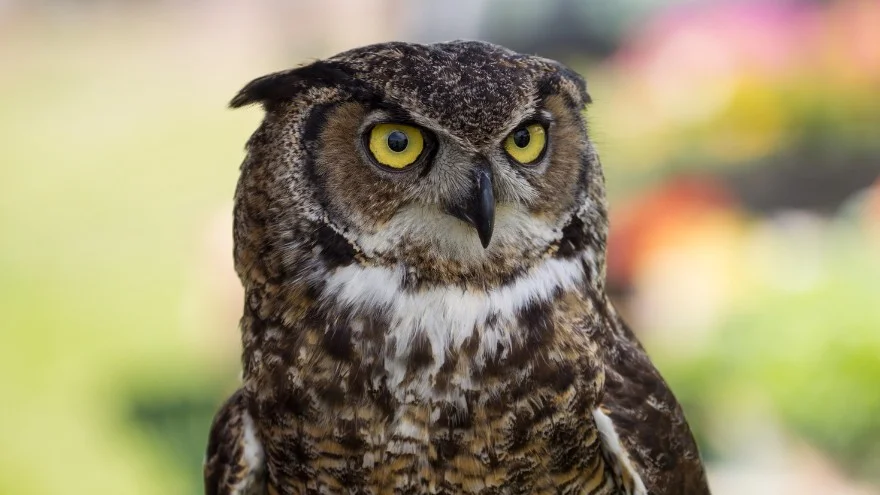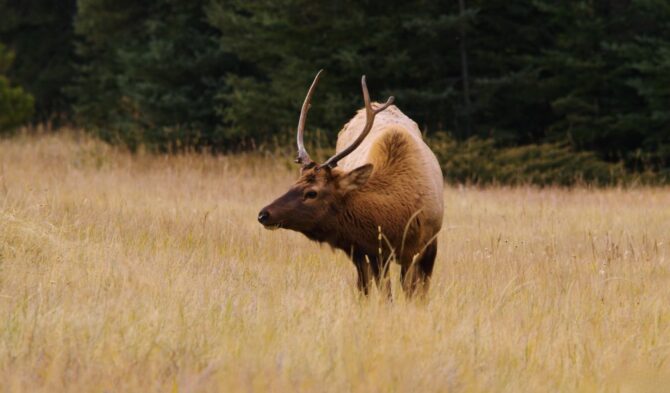Alabama is a state in the southeast of the United States that is renowned for its southern hospitality, its role as the home of the civil rights movement, and its history of civil rights conflicts.
More than 60 different types of natural habitats may be found in this state, including forests, woodlands, marshes, meadows, and grasslands.
In Alabama, these habitats are home to roughly 420 different bird species that have been identified. Owls are one of the many bird species found in the state.
There are up to 10 different species of owls in Alabama, including the barn owl, eastern screech owl, great horned owl, northern saw-whet owl, short/long-eared owl, and more.
In this article, you’ll discover some fascinating facts about owls in Alabama and how to recognize them based on their appearance, sounds, and migratory patterns.
The 10 Species of Owls in Alabama
1. Great Horned Owl
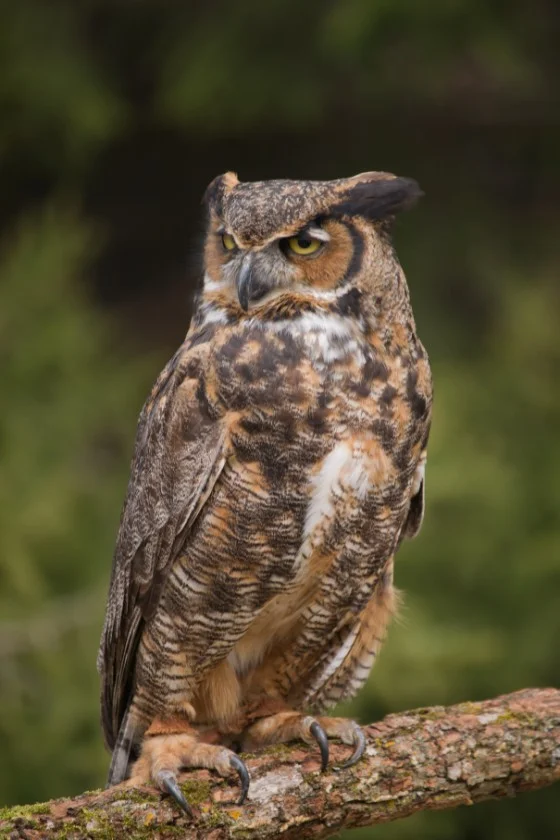
- Scientific Name: Bubo virginianus
- Length: 18.1 – 24.8 inches (46 – 63 cm)
- Weight: 910 – 2500 g (2.0 – 5.5 lbs)
- Wingspan: 39.8 – 57.1 inches (101 – 145 cm)
Great-horned owls are huge owls with barred bellies and a generally attractive grey top. Their colors differ according to region.
They have noticeable white feathering on their collar and protruding ear tufts. Their faces are sometimes referred to as having a “catlike” aspect.
All-year-round residents of Alabama, great horned owls are most prevalent from September through April. In Alabama, you can find them all year long.
Their capacity to survive in various settings is responsible for their extensive distribution. This includes backyards, cities, tundra edges, grasslands, rainforests, deserts, wetlands, and cities.
When it comes to owl hoots, the characteristic hoo hoo-HOO cry of great horned owls could be considered classic.
2. Eastern Screech Owl

- Scientific Name: Megascops asio
- Length: 6.3 – 9.8 inches (16 – 25 cm)
- Weight: 121 – 244 g (0.27 – 0.54 lbs)
- Wingspan: 18.9 – 24.0 inches (48 – 61 cm)
The Eastern screech owl is a small, stout-looking bird with no neck. About one-third of these owls are red but can also be grey.
They have “fake” ear tufts and a face disk with a black ring. They have white spots on their shoulders and blotchy patterns on their stomachs.
Alabama has the eastern screech owl all year long (you can spot them in almost all wooded areas). They typically mate for life, but the male will occasionally stray and mate with another female.
They speak with a quiet, horse-like, whinny tone. As they have superb concealment, the key to recognizing them is training your ears for their beautiful voice.
A variety of hoots, screeches, and whistles are among their calls. The most typical ones include a shrill, descending whinny and a tremolo, a continuous bouncing call.
3. Barn Owl
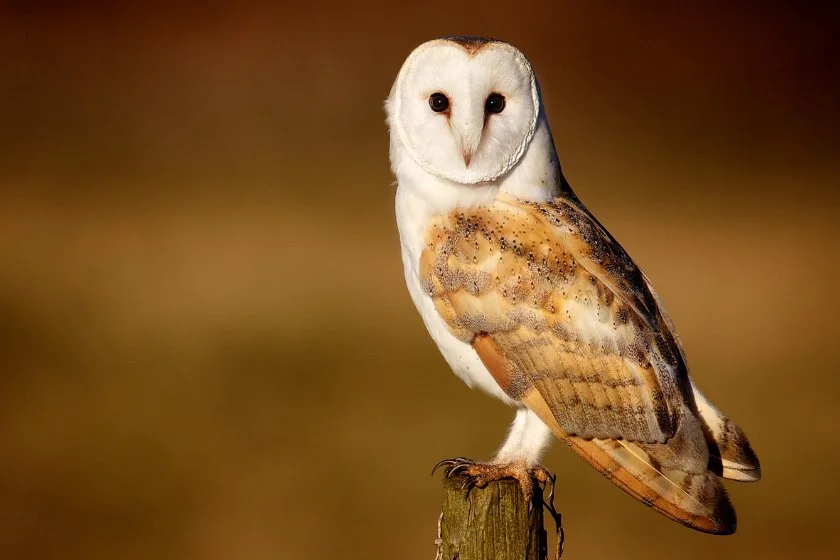
- Scientific Name: Tyto alba
- Length: 12.6 – 15.8 inches (32 – 40 cm)
- Weight: 400 – 700 g (0.9 – 1.5 lbs)
- Wingspan: 99.1 – 114.3 cm ( 39 – 45 inches)
Barn owls are distinguishable from others by their modest size, middle claws with serrations, and heart-shaped face disk.
Their tails are short and square, while their wings are long and rounded. They have bare feet and long legs.
The plumage of both sexes is generally comparable, even though females tend to be slightly larger and darker than males.
Their delicate white cheeks and underwings make them stand out in flight. The rest of their body might be buffy cinnamon, yellowish/gold, or even rusty in color.
All other owl species cannot be compared to these. They are the only members of their family to represent their family in North America (the other members of this list are “true owls” from the Strigidae family).
Because they are exclusively nocturnal, barn owls don’t show up during the day. In Alabama, these owls can be seen all year long.
Barn owls don’t make much “hoot,” unlike true owls. They yell, hiss, shriek, whistle, and screech instead.
The female will make a milder call when pleading for food, although these sounds are more typical of the male.
4. Short-Eared Owl
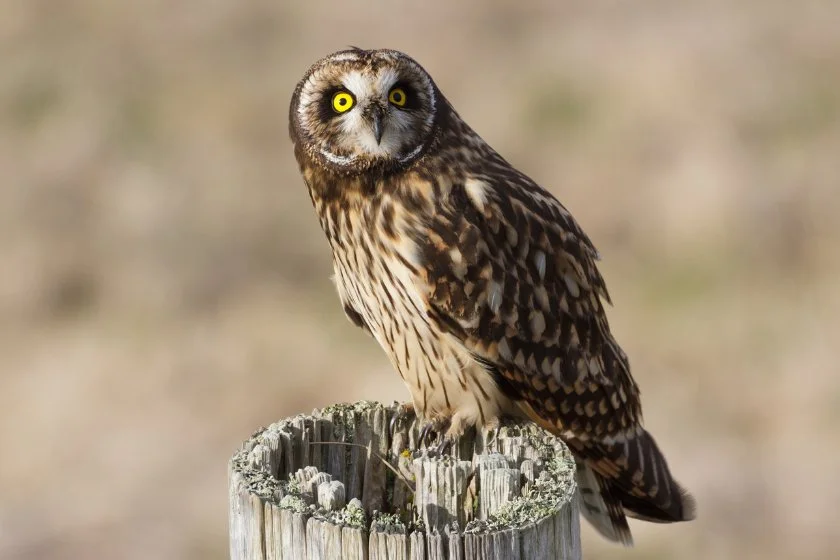
- Scientific Name: Asio flammeus
- Length: 13.4 – 16.9 inches (34 – 43 cm)
- Weight: 206 – 475 g (0.45 – 1.05 lbs)
- Wingspan: 33.5 – 40.5 inches (85 – 103 cm)
The short-eared owl is a medium-sized, tawny-brown mottled owl with a large geographic range in North America. They prefer to hunt on open terrain, including airports, farms, and marshes.
They prefer to breed further north, like their relative, the long-eared owl, although you might see one in Alabama in the winter from November to mid-March.
Because of their short ear tufts, which are rarely noticed until they are in a defensive position, short-eared owls are appropriately named.
These owls are frequently observed throughout the day because they hunt primarily in the dawn and twilight.
They will occasionally wait on the ground for prey, fly very low, and then swoop down to capture whatever food is presented to them.
Despite being secretive and challenging to identify, short-eared owls are among the most common in the world and can be found in some capacity in every state in the United States.
The short-eared owl does not have a loud voice. Males make their main call, a dozen or more hoots in succession, both in flight, on the ground, or from an elevated perch during courtship.
When defending the nest and young, males and females can bark, scream, or whine.
5. Burrowing Owl
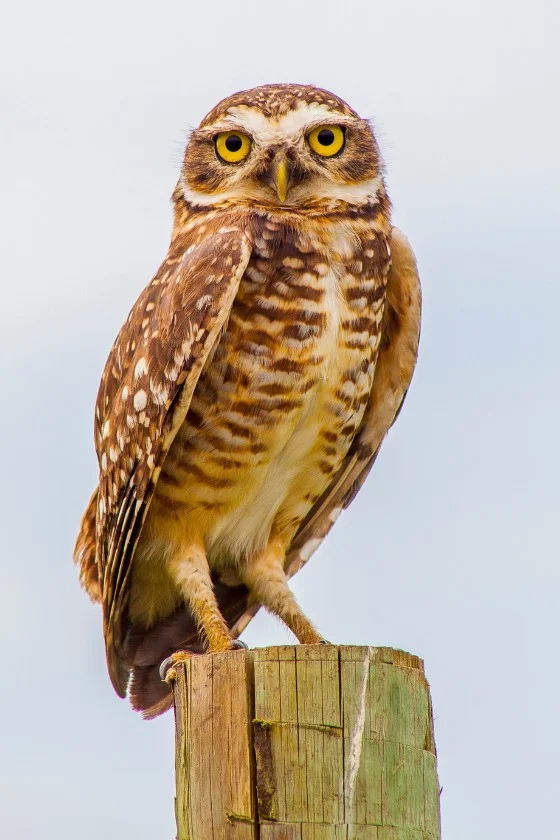
- Scientific Name: Athene cunicularia
- Length: 7 – 10 inches (17.8 – 25.4 cm)
- Weight: 140 – 240 g (0.3 – 0.5 lbs)
- Wingspan: 20 – 24 inches (50.8 – 61 cm)
Small, long-legged, Burrowing owls generally nest in prairie dog burrows (hence its name).
In Alabama, they are regarded as an uncommon or incidental species, and there have only been a few reports of sightings in the state’s southern regions.
Burrowing owls without ear tufts typically have brown feathers with numerous white patches.
They have yellow eyes, bills, and other features. Their chins have a white patch visible when they bob their heads or become agitated.
Burrowing owls can be found in agricultural areas, open meadows, deserts, and prairies. They nest in underground dens, hunt on the ground, and perch on fence posts.
6. Northern Saw-Whet Owl
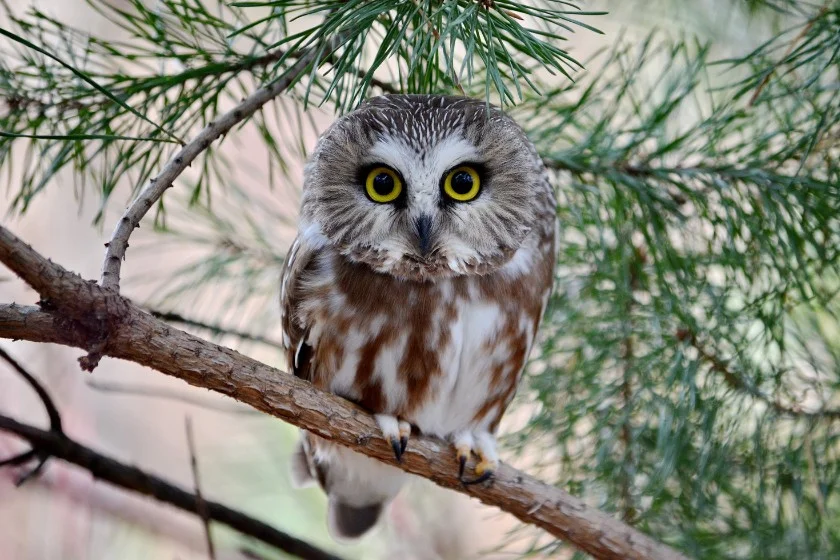
- Scientific Name: Aegolius acadicus
- Length: 7.1 – 8.3 inches (18 – 21 cm)
- Weight: 65 – 151 g (0.14 – 0.33 lbs)
- Wingspan: 16.5 – 18.9 inches (42 – 48 cm)
One of the smallest owls in North America, the Northern saw-whet owl, is comparable in size to a robin.
Small and brown, they have broad, rounded heads with faint white streaks. With strong white feathers forming a “Y” in between their bright yellow eyes, they have dazzling yellow eyes.
Their wings and backs have white dots on a brown background. They have white bellies and chests that have brown stripes.
The call of the saw-whet owl, which resembles a sawblade on a whetstone, may have inspired the bird’s name.
These owls live in dense coniferous forests where they conceal their nests among the tall branches and overhanging vegetation.
However, they prefer to live close to a field and a body of water where they can hunt.
Northern saw-whet owls are migratory, incredibly rare, and considered an unexpected species in Alabama. An extended string of urgent hoo sounds makes up a northern saw-whets call.
7. Long-Eared Owl

- Scientific Name: Asio otus
- Length: 13.8 – 15.8 inches (35 – 40 cm)
- Weight: 220 – 435 g (0.5 – 0.96 lbs)
- Wingspan: 35.4 – 39.4 inches (90 – 100 cm)
The name “long-eared owl” refers to these medium-sized, slender owls’ prominent ear tufts. Their upper parts have brown, white, buff, and gray splotches.
Their underparts are distinctively cross-barred with shades of orange, brown, black, and white. They have white tails with dark brown bars.
Due to their facial disc and mustache-like feathers around their bill, they exhibit a shocked face.
In Alabama, long-eared owls are an accidental species. In the state, they are incredibly uncommon.
These owls can be found near wide grasslands for hunting and in wooded environments with dense coniferous or deciduous trees for roosting. These trees’ dense foliage helps to conceal them from potential predators.
Although they are generally quiet owls, they will produce a slow, steady “whooo-whooo-whooo” call during the breeding season.
8. Snowy Owl
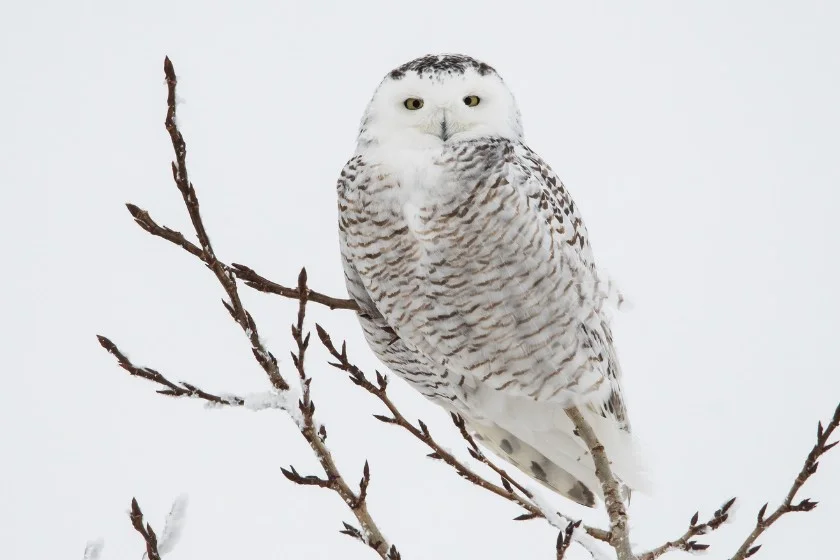
- Scientific Name: Bubo scandiacus
- Length: 20.5 – 27.9 inches (52 – 71 cm)
- Weight: 1600 – 2950 g (3.5 – 6.5 lbs)
- Wingspan: 49.6 – 57.1 in (126 – 145 cm)
To protect themselves from the icy, severe weather of the Arctic, snowy owls have bright yellow eyes and completely feathered legs and feet.
They have entire bars on their tails but only thick, dark bars on their wingtips. In Alabama, these owls are regarded as an incidental and vulnerable species.
Snowy owls can be found in the broad tundra of the Arctic, but they prefer to settle in places with vantage points like hummocks, ridges, knolls, and bluffs so they can keep a close eye on their surroundings.
They might go to areas with similar shrubby habitats to the Arctic, such as prairies, lakes, and coastal dunes.
In contrast to most other owls, snowy owls hunt throughout the entire summer day in the Arctic. They utter a loud, raspy “Hoo.” If threatened, they will also hoot, whistle, and hiss.
9. Barred Owl
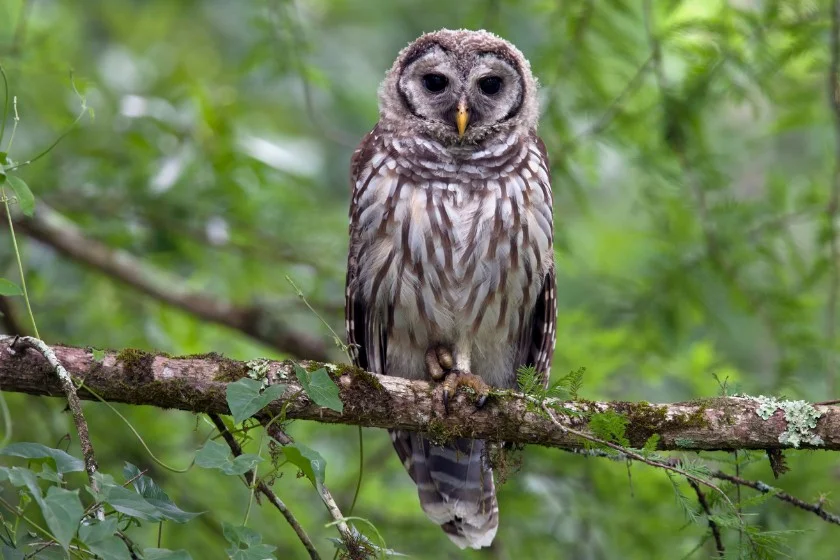
- Scientific Name: Strix varia
- Length: 16.9 – 19.7 inches
- Weight: 16.7 – 37.0 oz
- Wingspan: 39.0 – 43.3 inches
The tail and wings of barred owls are barred, and they are brown and white spotted. They have brown striping on their tan bellies. Don’t let their dark eyes deter you from making eye contact.
These owls like moist, mixed-forest habitats. This can include uplands, forested riverbanks, and marshes.
These owls can be seen all year round in Alabama. They prefer to stay put in place and not migrate.
Barred owls are more likely to be heard during the day than many other species are. They are rather easily summoned with imitation.
When you hear a call that sounds like someone asking, “who cooks for you? Who cooks for you all” while you’re outside at night, it’s probably a Barred Owl.
10. Flammulated Owl
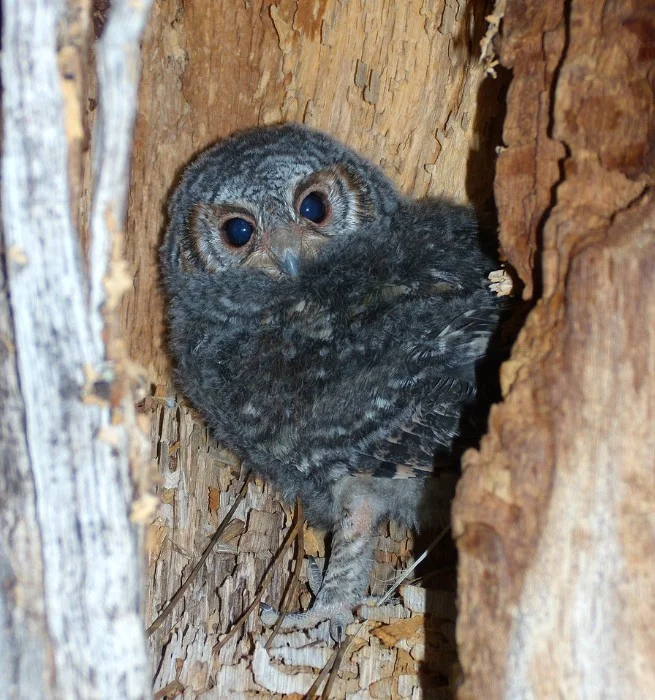
- Scientific Name:
- Length: 6 – 7 in (15 – 18 cm)
- Weight: 1.9 oz (54 g)
- Wingspan: 13 in (33 cm)
Flammulated owls are small migratory North American species.1 They are either gray or rufous in color and blend in well with trees.
Their dark eyes and white brows stand out against the reddish-brown color of their facial disk.
They are the only tiny owls with rectangular-shaped heads and black eyes (the others have yellow eyes).
The Latin word “flammeolus,” which means flame-colored or with flame-like markings, gave rise to the English name “flammulated owl.”
These little owls live in woodlands. They prefer settings with mature, open trees, particularly when there are many natural nesting cavities.
They yell, peep, and produce a variety of calls. Additionally, males also make low hoots.
Where to watch birds in Alabama?
Here are some of the best bird-watching hot spots in Alabama:2
- Birmingham Botanical Gardens (Jefferson County)
- Cheaha State Park (Cleburne & Talladega Counties)
- Cahaba National Wildlife Refuge (Bibb County)
- Little River Canyon National Preserve (DeKalb & Cherokee Counties)
- Lakepoint State Park (Barbour County)
Other Related Questions
What are the most common owls in Alabama?
The screech owl, barn owl, barred owl, and horned owl are the four owl species that are most prevalent in Alabama.
Will owls let you pet them?
An owl doesn’t like to be touched or held. If you do so, they might retaliate and accidentally hurt you with their beak or talons.
Wrap-up
Alabama is home to 10 different owl species, although some of these birds can’t be seen too often.
With excellent bird hotspots in the state, you have a great chance of seeing these amazing creatures. Ensure you stay safe while at it.
Next up…
References & Notes
- Linkhart D. B., Fox W. J., Yanco W. S. 2016. Migration timing and routes, and wintering areas of Flammulated Owls. Journal of Field Ornithology.
- Bird-watching Hot Spots in Alabama. Alabama Birding Trails.
